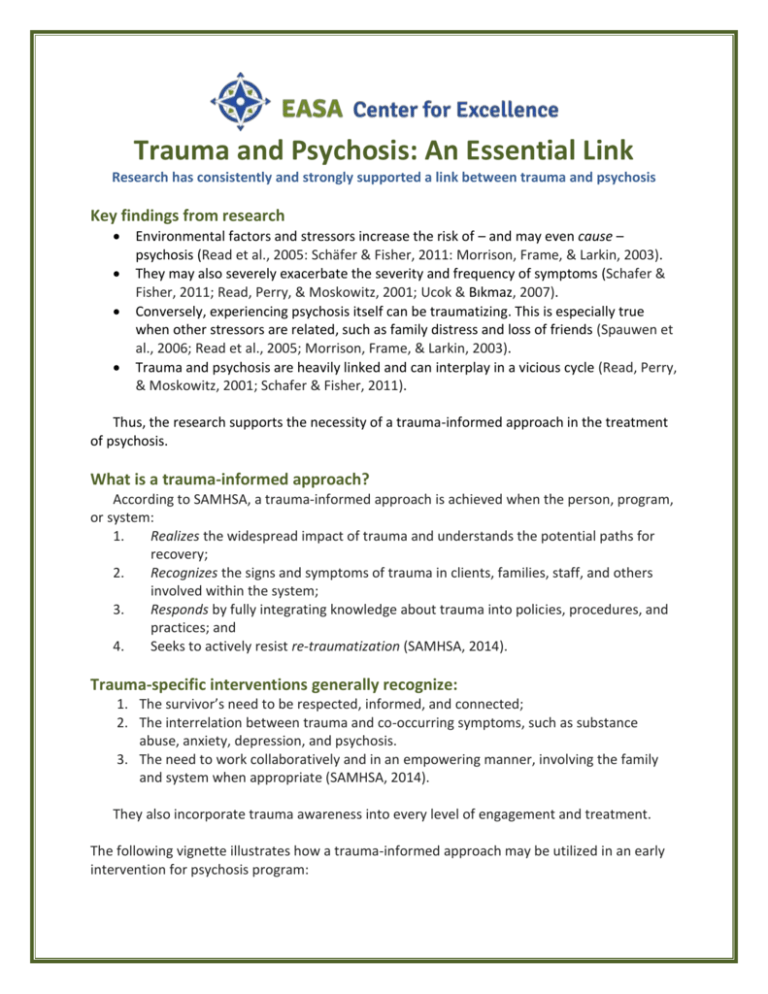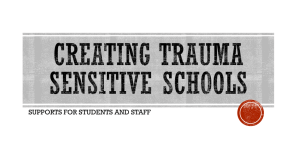Trauma and Psychosis
advertisement

Trauma and Psychosis: An Essential Link Research has consistently and strongly supported a link between trauma and psychosis Key findings from research Environmental factors and stressors increase the risk of – and may even cause – psychosis (Read et al., 2005: Schäfer & Fisher, 2011: Morrison, Frame, & Larkin, 2003). They may also severely exacerbate the severity and frequency of symptoms (Schafer & Fisher, 2011; Read, Perry, & Moskowitz, 2001; Ucok & Bıkmaz, 2007). Conversely, experiencing psychosis itself can be traumatizing. This is especially true when other stressors are related, such as family distress and loss of friends (Spauwen et al., 2006; Read et al., 2005; Morrison, Frame, & Larkin, 2003). Trauma and psychosis are heavily linked and can interplay in a vicious cycle (Read, Perry, & Moskowitz, 2001; Schafer & Fisher, 2011). Thus, the research supports the necessity of a trauma-informed approach in the treatment of psychosis. What is a trauma-informed approach? According to SAMHSA, a trauma-informed approach is achieved when the person, program, or system: 1. Realizes the widespread impact of trauma and understands the potential paths for recovery; 2. Recognizes the signs and symptoms of trauma in clients, families, staff, and others involved within the system; 3. Responds by fully integrating knowledge about trauma into policies, procedures, and practices; and 4. Seeks to actively resist re-traumatization (SAMHSA, 2014). Trauma-specific interventions generally recognize: 1. The survivor’s need to be respected, informed, and connected; 2. The interrelation between trauma and co-occurring symptoms, such as substance abuse, anxiety, depression, and psychosis. 3. The need to work collaboratively and in an empowering manner, involving the family and system when appropriate (SAMHSA, 2014). They also incorporate trauma awareness into every level of engagement and treatment. The following vignette illustrates how a trauma-informed approach may be utilized in an early intervention for psychosis program: Jeffrey has been experiencing hallucinations and very strange thoughts. He schedules an initial appointment with an early psychosis program. Shannon, the intake coordinator, knows that trauma and psychosis are highly correlated. She asks about trauma as a part of her biopsychosocial formulation. “I’m assessing to see if you’ve ever experienced psychological trauma,” Shannon explains. “While that definition is different from person to person, it usually means feeling so overwhelmed or hurt by something that it still affects your ability to feel safe. It can be a reaction to one really bad experiences, or a series of events over the years.” Jeffrey explains that he was once involuntarily hospitalized after experimenting with LSD and seeing some “weird stuff.” He says that he still has nightmares and intense intrusive flashbacks. After Jeffrey is admitted to the program, Shannon asks for his permission to share his trauma history with the treatment team. In doing so, she acknowledges the potential sensitivity of the content and invites Jeffrey’s participation in the treatment process. Jeffrey agrees. Miguel, his primary care clinician, lets Jeffrey know that he can discuss trauma only if he feels comfortable and ready to do so. When the relationship has been built and Jeffrey is ready, they talk in a safe space. Miguel uses active listening to gain information without judgment and validates Jeffrey’s experiences and emotions. With Jeffrey’s permission, he invites Jeffrey’s parents in for a family session. He knows that family involvement and support can be important for trauma recovery. Miguel provides psychoeducation about the impact of trauma and starts treatment planning. “Trauma,” he says, “is not something that people can just make go away. Healing will be a long process. What we can do now is work together to create a crisis plan for Jeffrey. It’s possible that another hospitalization could re-traumatize him, so we’re going to find alternatives. We’re also going to develop some strategies to help him manage just in case another hospitalization occurs.” Miguel collaborates with Jeffrey and his parents in developing a list of resources that will serve as alternatives to hospitalization. He also acknowledges that hospitalization may be necessary due to the psychosis. Jeffrey’s mom states she will accompany Jeffrey to the E.R., if necessary. Jeffrey agrees to that this would help. After this session, Miguel has weekly appointments with Jeffrey. He continues to be sensitive and patient. He utilizes the Trauma Affect Regulation: Guide for Education and Therapy (TARGET) model to design interventions. Finally, he listens to Jeffrey’s feedback and invites Jeffrey to be a leader in his own treatment process. Resources: Morrison, A., Frame, L., & Larkin, W. (2003). Relationships between trauma and psychosis: A review and integration. British Journal of Clinical Psychology, 42, 331-353. Read, J., Perry, B.D., Moskowitz, A., Connolly, C. (2001). The contribution of early traumatic events to schizophrenia in some patients: a neurodevelopmental model. Psychiatry, 64 (4), 319-343. Read, J., van Os, J., Morrison, A., & Ross, C. (2005). Childhood trauma, psychosis, and schizophrenia: a literature review with theoretical and clinical implications. Acta Psychiatrica Scandinavia, 112, 330-350. Schäfer, I., & Fisher, H. (2011). Childhood trauma and psychosis—what is the evidence? Dialogues in Clinical Neuroscience - Vol 13 . No. 3 . 2011, 13(3), 360-365. Spauwen, J., Krabbendam, L., Wittchen, H., & Van Os, J. (2006). Impact of psychological trauma on the development of psychotic symptoms: Relationship with psychosis proneness. The British Journal of Psychiatry, 188, 527-533. Trauma-Informed Approach And Trauma-Specific Interventions. (2014, January 1). Retrieved from http://beta.samhsa.gov/nctic/traumainterventions Ucok, S., Bıkmaz, S. (2007). The effects of trauma in patients with first-episode schizophrenia. Acta Psychiatrica Scandinavia, 116, 371-377.







